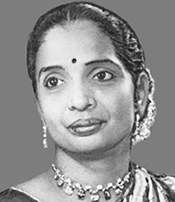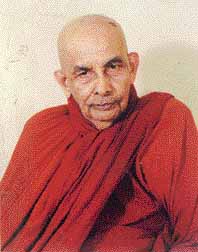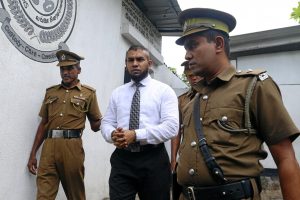by Sachi Sri Kantha, April 8, 2020
Twenty years have passed since the death of Dr. Siva Chinnatamby (1923-2000), an eminent Eelam Tamil woman physician. For her times, she was one of the rare women bio-medical scientists from Ceylon who received international recognition for her contributions to women’s health.

Young Dr. Siva Chinnatamby
Recently, while net surfing, I came across an interesting Ph.D. thesis by Darshi Nayanathara Thoradeniya, submitted to the University of Warwick (UK), in 2014, with the title ‘Women’s Health as State Strategy: Sri Lanka’s Twentieth Century’. It was a hefty tome of 339 pages, with five chapters in addition to the Introduction and Conclusion. To my surprise, I found that chapter 3 entitled ‘From Pincus’ Pill to Chinnatamby’s Vanda Beheth and Women’s Female Friend Mithuri (1950-1980)’ describes the professional career of Dr. (Miss) Siva Chinnatamby, and the conflict she faced in conducting the oral contraceptive pill trials in 1960s with the Buddhist Sinhalese extremists, the likes of Ven. Madihe Pannaseeha Thero (1913-2003). Vanda beheth in Sinhalese language is translated as ‘sterility pill’. Pincus in the chapter title refers to Greogry Pincus (1903-1967), American zoologist – a co-inventor of oral contraceptive pill.
The first two paragraphs of the abstract of this chapter is as follows:
“This chapter charts the history of the Pill in Sri Lanka to illustrate how the broader global discourse of population control has played out in the Sri Lankan national context. It explores the fraught story of Sri Lanka as a site for Pill trials in the 1960s, and provides a narrative of popular reactions to the widespread availability of the Pill by the mid-1970s. In particular, the chapter explores how universal population control as a development discourse of the state came under strain when confronted by the challenges of maternalist policies in an ethnically divided nation.
Through a cross reading of Sri Lankan research reports and the correspondence between Sri Lankan and International family planning pioneers, I show how Sri Lanka became a laboratory for global Pill trials. This prompted a discussion on contraception that revolved around morality, women’s bodies and ethnicity resulting in the Pill being labelled vanda beheth/pethi (sterility pills) in the late 1960s.”
Pages 169 to 172 of the thesis provide a synopsis of the professional career of Dr. Siva Chinnatamby. Though Thoradeniya mentions the year of birth of Dr. Chinnatamby as 1921, but I vaguely guess it should be 1923. I also had read that the first name ‘Siva’ is a shortened dimunitive her birth name. Sanmugam Arumugam’s biographical compilation, Dictionary of Biography of the Tamils of Ceylon (1997) carries an entry for Dr. Chinnatamby, and indicates her year of birth as ‘c. 1930’. This is definitely in error; because in 17 years, she couldn’t have completed her medical degree and begun her career in 1947 as the house surgeon at the De Soysa Hospital for Women in Colombo.

Madihe Pannaseeha Thero (1913-2003)
In page 187 of her thesis, Darshi Thoradeniya states that “Sinhalese nationalists sought to cast suspicion on the link between Chinnatamby’s ethnic identity and the oral contraceptive introduced by her, which they perceived as a weapon to make Sinhalese women sterile.” and provides a citation to Ven Madihe Pannaseeha Thero’s article, [‘Upath Palanaya Sinhalayan Vanda Kireemakda?’ (Does Birth Control suggest the extinction of the Sinhala Race?), Silumina 12 August (Tuesday), 1969, p.3] that appeared in the Sinhala language weekly published by the Lake House Ltd.
Two pages later, Thoradeniya had inferred, “At that time, Sinhalese Buddhists portrayed Chinnatamby as someone attempting to disturb the ethnic balance of the country by using vanda beheth/pethi as a weapon. However, when delving into the historiography of the Pill trials in Sri Lanka, it becomes evident to me that the question at stake was not Chinnatamby’s ethnicity but women’s health.” That Thoradeniya had attempted to soft-pedal the issue of Chinnatamby’s Tamil ethnicity needs emphasis. I infer that Sinhalese nationalists have a paranoia that Tamil or Muslim ethnics in the blessed island have been attempting to suppress them to a minority. Why? The same vanda beheth/pethi logic cropped up again last year, against a Muslim male doctor

Dr. Segu Shihabdeen Mohamed Shafi (in white shirt and tie)
Segu Shihabdeen Mohamed Shafi as well. He was arrested after accusations of secretly sterilizing Buddhist women after Caesarean deliveries. Check this news item. [https://www.reuters.com/article/us-sri-lanka-doctor-insight/unsubstantiated-claims-muslim-doctor-sterilized-women-raise-tensions-in-sri-lanka-idUSKCN1T71HS]
Research Publications of Siva Chinnatamby
Unfortunately Dr. Thoradeniya’s 2014 Ph.D thesis (University of Warwick,
http://wrap.warwick.ac.uk/63815/1/WRAP_THESIS_Thoradeniya_2014.pdf)
provides only 3 references to Dr. Chinnatamby’s ‘publications’ from local sources. Two of them were in the 11th and 17th Annual Reports of the Family Planning Association (Ceylon). The third one was also in a publication ‘Fifteen Years of Family Planning in Ceylon 1953-1968’ published in 1969. Pagination for all three references were missing. This is far from satisfactory. Dr. Sinnathamby did publish more in her research specialty. Even in my previous 2009 compilation of ‘Sri Lankan Tamil Scientists: An inventory of their productivity’[https://sangam.org/2009/03/Scientists.php?uid=3345] had only 2 publications for Chinnatamby, that was based on the ‘data indexed in the ISI Web of Science database’ as of Dec. 31, 2008.
I provide a following update of Dr. Siva Chinnatamby’s publications, compiled from three other reputable sources: PubMed database, H.A.I. Goonetileke’s ‘A Bibliography of Ceylon (Sri Lanka) volumes I-V, as well as Kamalika Pieris and C.G.Uragoda’s ‘Bibliography of Medical Publications relating to Sri Lanka, 1811-1976’.
- Thiagarajah PR and Chinnatamby S. Analysis of the maternal deaths in the de Soysa Maternity Hospital during the period 1948-1953. Journal of the Ceylon Obstetrical and Gynecological Association, 1954; 1: 66-79.
- Caldera R and Chinnatamby S. An analysis of the work done in the De Soysa Maternity Hospital in 1954. Journal of the Ceylon Obstetrical and Gynecological Association, 1954; 1: 83-110.
- Chinnatamby S. Family planning in the social set-up of Ceylon. Ceylon Labour Gazette, 1956; 7(2): 33-37.
‘Adapted from a report presented to the Fifth International Conference on Planned Parenthood, Tokyo, 1955. Discusses births by age of mother, maternal neonatal mortality rates in relation to income; present policy on abortion and sterilization.’
- Chinnatamby S: Fertility trends in Ceylonese women. Journal of Reproduction and Fertility, June 1962; 3: 342-355.
- Chinnatamby S. Sterilization: salpingectomy. Proc of the Seventh Conference of the International Planned Parenthood Federation, Singapore, 1963. Amsterdam: Excerpta Medica, 1964 (Excerpta Medica International Congress Series No. 72), pp. 237-238.
- Chinnatamby S. I. Clinical trial and oral contraceptives Envoic and Conovid E. II. Effect of oral contraceptives (Conovid E) on lactation. Proc of the Seventh Conference of the International Planned Parenthood Federation, Singapore, 1963. Amsterdam: Excerpta Medica, 1964 (Excerpta Medica International Congress Series No. 72), pp. 319-322.
- Chinnatamby S. Simple method acceptability study. Proc. of the Seventh Conference of the International Planned Parenthood Federation, Singapore, 1963. Amsterdam: Excerpta Medica, 1964 (Excerpta Medica International Congress Series No. 72), pp. 600-604.
- Chinnatamby S. Effect of oral contraceptives on lactation. Proc. of the Eighth International Conference of the International Planned Parenthood Federation, Santiago, Chile, 9-15 April 1967, London: IPPF, 1967, pp. 263-267.
- Chinnatamby S: Intrauterine contraceptive device and population. British Medical Journal, 25 Sept.1965; 2(5464): 756.
- Chinnatamby S: Contraceptives and lactation. International Planned Parenthood Federation Medical Bulletin, 1967; 1(4): 2.
- Chinnatamby S. Long acting injectable Depo Provera as a contraceptive. Journal of Obstetrics & Gynecology of the Association of Obstetricians and Gynecologists of Ceylon, 1969; 130-136.
- Chinnatamby S: Infertility services in a family planning clinic. International Planned Parenthood Federation Medical Bulletin 1970; 4(2): 3-4.
- Chinnatamby S: A comparison of the long-acting contraceptive agents norethisterone oenanthate and medroxyprogesterone acetate. Australian New Zealand Journal of Obstetrics and Gynecology, Nov. 1971; 11(4): 233-236.
- Chinnatamby S: Effects of ‘Nordiol’ on fertility and lactation: some preliminary observations. Current Medical Research and Opinion, 1973; 1(6): 376-378.
- Chinnatamby S. Acceptability of long-acting injectable preparations by women in Sri Lanka. Proc. First International Scientific Congress of the Family Planning Association of Sri Lanka, Colombo, 1974. Colombo: Family Planning Association of Sri Lanka, 1975, pp. 84-87.
- Chinnatamby S. Bibliography on human reproduction, family planning and population dynamics – annotated articles and unpublished work in the South-East Asian region, Special supplement No.2, 1974 on family planning programmes (including review of current status). New Delhi, WHO Regional Office for South East Asia, 1975, 40, 110 p.
‘Review of current status – Sri Lanka’ pp. 81-96, map, 2 charts, 6 tables. The information is based on sources available up to mid 1974’.
- Chinnatamby S: The effect of oral contraceptives on nutritional status and metabolism of the Asian woman (Sri Lanka). Future – The Newsletter of the IPPF Indian Ocean Region (Colombo), 1978; 5(2): 10-11.
- Chinnatamby S. Basnayake S, Nichoalds GE. Evaluation of the health and nutritional status of women in Sri Lanka. Asia Oceania Journal of Obstetrics and Gynecology, 1980; 6(2): 141-148.
- Chinnatamby S: Role of planned parenthood for enrichment of the quality of life in Sri Lanka. Ceylon Medical Journal, Dec.1990; 35(4): 136-142.
Published Biographical details on Dr. Siva Chinnatamby
Roshan Peiris: ‘Given a chance, I’ll be this again’ (interview). Sunday Times (Colombo), Jan.9, 2000.
Wilfred Perera: Dr. Siva Chinnatamby. Island (Colombo), Feb.22, 2001.
I had located the obituary reference, which indicates that the year of birth of Dr. Siva Chinnatamby is 1923. It is as follows:
O & G (Royal Australian and New Zealand College of Obstetricians & Gynecologists) March 2001, vol.3, no.1, pp. 49-50.